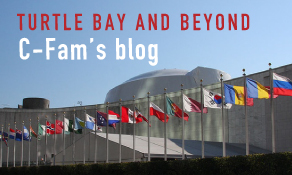NEW YORK, September 8 (C-Fam) Western countries want to remove the term “child pornography” from a UN Cybercrime Convention. They further want to eliminate some forms of engagement with child porn in a list of criminal acts.
Last month, UN member states began negotiating an international convention to combat cybercrime that is intended to increase collaboration among member states to go after cybercrime. However, some Western countries are promoting a new standard for child pornography that may leave children unprotected from sexual exploitation.
The U.S., UK, and EU want to remove the term “child pornography” from the convention and replace it with “online child sexual abuse” or “child sexual exploitation material.”
This new language is the result of a multi-year campaign by advocates and UN agencies to target sexual abuse in the making of pornographic material, and not just the possession and transmission of child pornography. The Friday Fax previously reported that some experts argue this change is problematic. Some UN agencies and Western governments are using this as an occasion to promote a broader agenda of sexual autonomy for adolescents.
By their own admission, UN agencies say the new terminology might exclude certain sexual materials involving children, such as consensual sexting between adolescents or other sexually suggestive content, in the process making it harder to prosecute some images that would otherwise be considered child pornography. Some UN agencies say this is desirable in order to “de-stigmatize” sexual behavior between adolescents and to distinguish between legal and illegal pornography.
In a statement to the Friday Fax, an EU representative said that producing such material would include both broadcasting and publishing.
Online access to pornography not only contributes to child abuse but also to sex trafficking. The University of New Hampshire reports that “sex traffickers may…use technology to make connections with other offenders, for example, networking among pimps or child pornography rings, or for business aspects of trafficking such as online banking and ordering clothes and other goods for victims.”
The use of information and technology services can impact the scale and scope of offenses related to trafficking in persons. Yet, outside of the preamble, the issue of human trafficking is not discussed or alluded to anywhere else in the 52-page convention draft.
The proposed convention also affirms the commitment to mainstreaming what feminists call a “gender perspective.” UN Women defines gender perspective as “the process of assessing the implications for women and men of any planned action, including legislation, policies or programmes, in all areas and at all levels.” This strategy, initially endorsed by the 1995 Fourth World Conference on Women, is now streamlined in various UN conventions and agency reports and is mandating countries to adopt a legislative perspective that considers a broad series of gender-specific considerations, including for those who identify as transgender and intersex.
The Ad Hoc Committee in charge of elaborating and delivering the Convention will host its concluding session from 29 January – 9 February 2024. That will represent the final opportunity for member states to discuss and negotiate the text before it is arranged for a vote at the General Assembly.
View online at: https://c-fam.org/friday_fax/will-un-member-states-allow-transmission-of-child-prn/
© 2025 C-Fam (Center for Family & Human Rights).
Permission granted for unlimited use. Credit required.
www.c-fam.org









